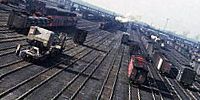Rick Karr, Blueprint America correspondent
 Regarding our recent piece on freight rail, a viewer commented:
Regarding our recent piece on freight rail, a viewer commented:
“[Karr] neglected to mention that in Western Europe
most trains are electric, which accelerate more quickly, and don’t
use oil.”
The viewer is right about the basics — electrified trains are powerful, and depending on the source of electricity, can lead to less pollution.
Surprisingly, it was a U.S. railroad that proved the viability of electrified freight rail. Its story says a lot about the way we’ve approached big infrastructure projects over the years.
Late in the 19th Century, The Milwaukee Road found itself in an unenviable position: Five other railroads had already traversed the continent. The remaining available routes connecting the Plains to the West Coast across the Rockies were… less than ideal. The route that was most logical for the Milwaukee Road included a steep climb through the Rocky Mountains near Yellowstone Park, and its locomotives would have to operate in brutal winter cold – extremely difficult conditions for the steam locomotives of the day.
But the Milwaukee Road also found itself in a position to take advantage of new technology. Its five transcontinental competitors thought of trains as the old-fashioned way — the way in which engineers
had been thinking about them since the days of George and Robert Stephenson in Britain. In other words, trains had to haul their own power supply with them, carrying the coal (or wood or oil) that provided the energy, as well as a way to turn that energy into motion.
The alternative was to use the fuel to generate power in one location and transmit that power to the train, which would then only have to turn the power into motion. The Stephensons’ rival, Isambard Kingdom Brunel, tried to make that work, but his pneumatic system was a very inefficient forerunner to electricity and his line abandoned central power generation after just a year.
By the late 19th Century, electrical traction had advanced enough to make this all possible. So the Milwaukee Road dammed waterways near its tracks and installed hydroelectric turbines to generate electricity. It mined copper in the Rockies, and built overhead wires from that copper to carry power to its electric locomotives. What’s more, the railroad helped to pioneer a system in which trains generate energy as they apply their brakes while descending from the mountains –- power that could be pumped back into the overhead wires to help other trains climb the mountains.
All in all, it was a brilliant scheme. Despite its late start, the Milwaukee remained competitive. More importantly – at least from the perspective of this story – it inspired awe and attracted engineers and entrepreneurs from around the world who examined its design and engineering, then rushed home to implement its lessons on other lines.
What happened later wasn’t pretty. Competition from trucks and other railroads put pressure on the Milwaukee Road. In the late 60s, several of its competitors merged, which put even more pressure on
the line. By the early 70s, the railroad had deferred maintenance on the line to the point where it was difficult to compete at all. Finally, in 1973, its board of directors went against the advice of consultants and voted to replace the electric locomotives with diesel units. It also voted to pull down the overhead wires – an
attractive proposition, given that a copper shortage suggested that the line could sell the wires for $10 million as scrap.
It didn’t help. Oil prices soared, which made the diesel option much more expensive. Copper prices fell, which meant the Milwaukee Road generated only $5 million. By 1977, the railroad had filed for bankruptcy and abandoned its tracks from the Rockies to the Pacific Coast.
The Milwaukee Road proved that electrified freight railroads were practical and efficient – as long as management was willing to keep up maintenance on the generators and distribution wires. While European railroads adopted the technology, it’s not the path that other U.S. railroads chose. And even though some freight-rail advocates –- like our viewer and Washington Monthly journalist Phillip Longman –- think electrification would be a good idea today, industry officials disagree. First off, the investment would be huge –- hundreds of billions of dollars nationally. Second, one of the ways in which freight rail has maintained its profitability has been by stacking freight ever higher –- double-decker intermodal cars and triple-decker car carriers. Long story short, it’d be very difficult to build and maintain overhead wires that could accommodate today’s tall trains.


